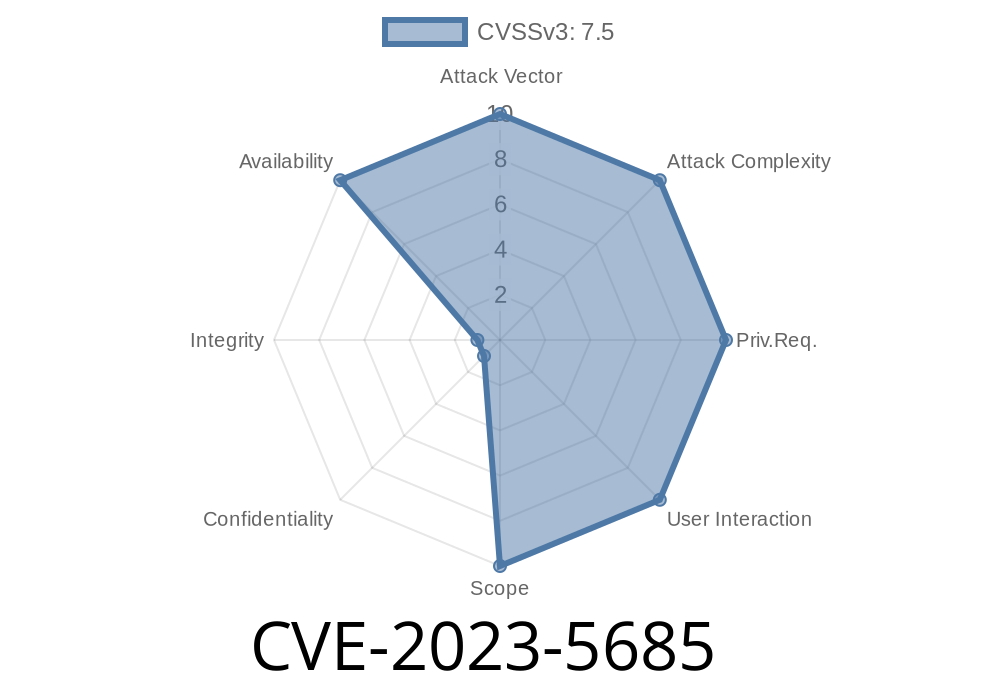_In late 2023, a serious flaw was discovered in the XNIO library—a common networking library used by popular Java application servers like WildFly and Undertow. This flaw, tracked as CVE-2023-5685, may let attackers crash servers and cause denial of service (DoS) by triggering a stack overflow exception through the NotifierState system._
Let’s break down how this vulnerability works, provide a look at the code behind it, and learn how it can be exploited—using simple terms with examples.
What is XNIO and Why is This Flaw Critical?
XNIO is a low-level, fast I/O library often used as a foundation for handling non-blocking network operations in Java applications. Web servers built on technologies like WildFly and Undertow rely on XNIO for connection handling.
The NotifierState system in XNIO is designed to manage notifications for state changes in the system—like when a connection is ready for reading or writing.
In CVE-2023-5685, a bug was found where creating a deeply nested chain of NotifierStates can cause the Java Virtual Machine (JVM) to overflow the stack, leading to an unhandled exception. This kills the process or thread, potentially bringing down your whole application. Since this can be triggered by a remote attacker, it opens the door to denial-of-service (DoS) attacks.
The Chain Reaction in NotifierState
NotifierState objects form a chain when multiple notifications are queued. Here’s a simplified pseudo-version of how NotifierState handles notifications:
// Simplified version
public abstract class NotifierState {
protected NotifierState next;
public void notifyListener() {
if (next != null) {
next.notifyListener(); // Recursive call!
}
// Handle this notification
}
}
If an application queues up thousands of notifications, this chain could be thousands of elements long. Because the notifyListener() call is recursive, Java must create a new stack frame for each call. Eventually, with enough depth, the stack overflows.
Real-World Example: Creating a Large Chain
Suppose an attacker triggers connections or operations in a way that thousands (or even millions) of NotifierStates get queued.
NotifierState head = new SomeNotifierState();
NotifierState current = head;
for (int i = ; i < 100000; i++) {
NotifierState ns = new SomeNotifierState();
current.next = ns;
current = ns;
}
// Trigger the chain
head.notifyListener(); // StackOverflowError risk!
When head.notifyListener() is called, it recursively calls down the chain. If the chain is too long, the program crashes with a java.lang.StackOverflowError.
Exploit Details: How Attackers Can Crash Your Server
1. Trigger Many State Changes: The attacker sends crafted requests (for example, opening many connections or performing actions that generate state changes) to cause XNIO to queue up an excessively long NotifierState chain.
2. Force Notification Processing: The system eventually tries to process all notifications, causing the recursive calls.
Here’s a simplified (pseudocode) exploit scenario for demonstration
// Suppose the server handles notifications from user events
for (int i = ; i < 100000; i++) {
// Attacker floods the server with events/connections
sendEventToServer();
}
// Server tries to process queued NotifierStates
// This triggers stack overflow
The actual exploit will depend on how the application or framework uses XNIO, but the principle is the same: force enough events to stack up and crash the server.
Are You Vulnerable?
If you use an application that embeds XNIO (WildFly, Undertow, JBoss EAP, etc.) and accepts data from the network, you could be at risk if:
- You run an unpatched version of XNIO (typically before XNIO 3.8.6.Final)
Patching and Mitigation
- Upgrade to the latest version of XNIO (3.8.6 or later), which fixes the flaw by using a non-recursive approach or capping chain depth.
Monitor for excessive connection or event requests as an indicator of attack.
- In layered architectures, consider handling fatal errors at the container or orchestration level to restart crashed processes.
References
- NIST CVE-2023-5685 Official Entry
- Red Hat Bugzilla - CVE-2023-5685
- XNIO GitHub Releases
- Undertow Advisory - StackOverflow in NotifierState
Conclusion
CVE-2023-5685 shows that even deep system modules like XNIO can fall victim to classic stack overflow problems, especially when handling user-supplied network data. Understanding how overflow happens—and ensuring up-to-date libraries—are critical steps to safeguard Java servers from denial-of-service attacks.
If you administer or develop Java server software, patch and test your system now. For more details, check out the official advisory and XNIO’s GitHub.
Timeline
Published on: 03/22/2024 19:15:07 UTC
Last modified on: 03/25/2024 01:51:01 UTC
